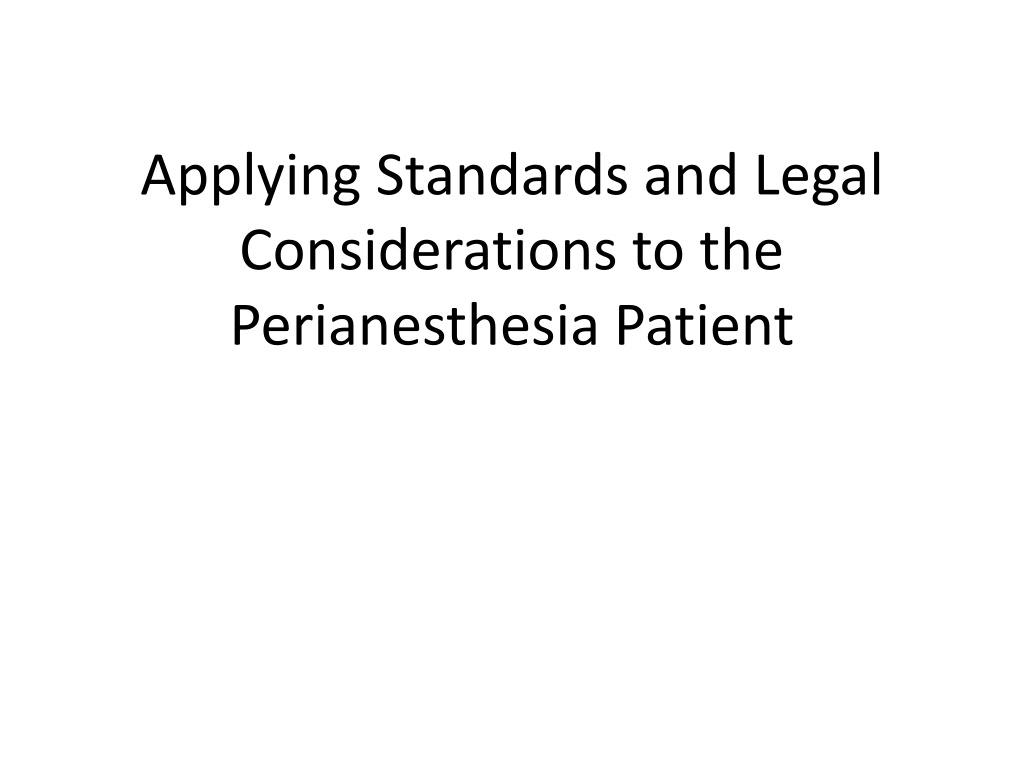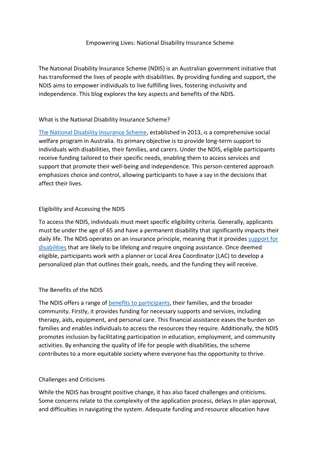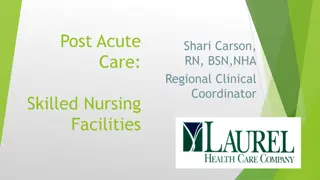Understanding Standards of Care in Perianesthesia Nursing
Exploring the significance of national standards and legal considerations in perianesthesia care, this content delves into the nursing standard of care, standards of nursing care, and the aspects of professional performance involved in providing quality patient care. It discusses the elements essential for proving negligence in malpractice cases and common documentation pitfalls while emphasizing the roles of organizations like ASPAN, The Joint Commission, and the American Nurses Association in establishing and upholding standards of care in healthcare settings.
Download Presentation

Please find below an Image/Link to download the presentation.
The content on the website is provided AS IS for your information and personal use only. It may not be sold, licensed, or shared on other websites without obtaining consent from the author. Download presentation by click this link. If you encounter any issues during the download, it is possible that the publisher has removed the file from their server.
E N D
Presentation Transcript
Applying Standards and Legal Considerations to the Perianesthesia Patient
Objectives Identify the role National standards have in your everyday practice in caring for patients in the perianesthesia arena. Identify 4 elements essential for proving negligence in malpractice cases. Describe most frequent documentation pitfalls.
What does the nursing standard of care mean?
Nursing Standard of Care Describes kind of care the patient can expect and receive from the nurse. Authoritative statements that describe competent level of clinical nursing practice demonstrated through the nursing process.
Standards of Nursing Care Are any established measure of extent, quality, quantity Value an agreed upon level of performance a degree of excellence of care that is established
Standards of Care Describes a competent level of care: assessment diagnosis interventions evaluation
Standard of Care Professional Performance Describe what nurses do for or with patients and patient families Authoritative statements describing competent level of behavior Include quality assurance (performance improvement), ethics, education, consultation, research, peer review, accountability Nursing Care Describes kind of care patient can expect and receive from the nurse Authoritative statements that describe competent level of clinical nursing practice demonstrated through the nursing process assessment, diagnosis, interventions, and evaluation
Who May Establish Standards of Care? ASPAN The Joint Commission The American Nurses Association (ANA) Institutional rules or hospital standards developed by institutions for their staff and patients
Who May Establish Standards of Care? Unit practice standards, policies, protocols are specific standards of care for specific groups of types of patients Precedent court cases define what a reasonable, prudent nurse would have done in a similar situation Specialty nursing organization standards standards developed nursing specialty organizations (ASPAN, AACN, AORN, ENA)
Who May Establish Standards of Care? Certification in a specialty area as a means by which a professional organization attests that an individual has attained proficiency in an area of that profession s practice
What are the current ASPAN Standards? 2017-2018
STANDARDS 2017-2018 Perianesthesia Nursing Standards, Practice Recommendations and Interpretive Statements This text contains standards of perianesthesia nursing practice evidence-based clinical practice guidelines practice recommendations position statements resources from partnering organizations interpretive statements
ASPAN Standards Include Standards: generic statements which best describe the desirable and achievable level of performance Guidelines: developed from systematic review of literature and research, a prime tool for evidence based practices, and require frequent updating as new information becomes available Practice Recommendations: which best describe the desirable and achievable level of performance expected of perianesthesia registered nurses.
ASPAN Standards Include Position Statements: represent an organization s viewpoint on a particular issue Resources: recommendations for practice based primarily on expert consensus, expertise and opinion from partnering organizations INTERPRETIVE STATEMENTS provided in sidebar format offer clarification, definitions and examples
2017-2018 Standards Effective January 1, 2017 Revised and expanded Includes: Scope of Perianesthesia Nursing Practice Principles of Perianesthesia Practice Ethical Practice Safety 6 Standards 11 Practice Recommendations 15 Position Statements 5 Resources including Clinical Practice Guidelines (posted on web site http://www.aspan.org)
Scope of Perianesthesia Nursing Practice Preanesthesia level of care Preadmission Day of surgery/procedure Postanesthesia levels of care Phase I Phase II Extended Care Settings
Perianesthesia Standards for Ethical Practice Competency Responsibility to patients, Professional responsibility, Collegiality, Research, Advocacy
Principles of Safe Perianesthesia Practice ASPAN s core values for a culture of safety include Communication Advocacy Competency Efficiency/Timeliness Teamwork
Standards of Perianesthesia Nursing Practice
I. Patient Rights Perianesthesia nursing practice is based on philosophical and ethical concepts that recognize and maintain autonomy, confidentiality, dignity and worth of individuals Criteria Written policies exist for identifying and resolving ethical dilemmas Nursing practice reflects an understanding of ethical, moral and legal issues
Standard I: Patient Rights Case Nurse loses position for breach of confidentiality through computer entry into patient files including diagnostics and other privileged information. Hospital/facility has policy regarding patient confidentiality
Standard II: Environment of Care Standard: Perianesthesia nursing practice promotes and maintains a safe, comfortable and therapeutic environment. Outcome: patient, staff & visitor will be free from adverse effects associated with environmental and safety factors Criteria: Phase I level of care is in close proximity where anesthesia is administered
Criteria: Preanesthesia, Phase I, Phase II and Extended care are distinct levels of care Perianesthesia areas adhere to institution- specific practices regarding access, security and safety. Preanesthesia patients are separated from patients undergoing procedures and/or recovering from anesthesia/sedation
Standard II Environment of Care Case QI shows increased patient nausea and vomiting when preoperative and postoperative patients are mixed in same room. Mother transports infant home without second person in auto. Child has obstructed airway Patient with latex allergy is exposed to use of non- powdered latex gloves while in PACU
Standard III: Staffing and Personnel Management Standard: Appropriate number or RNs with demonstrated competence available in each level of care based on Patient acuity Census Patient flow process Physical facility
III. Staffing and Personnel Management Criteria Staffing patterns Staff function within job performance descriptions Orientation plan Performance appraisals Staffing based on patient acuity, census, and physical facility Written staffing policy
III. Staffing and Personnel Management Criteria The perianesthesia nurse providing Phase I level of care will maintain current Advanced Cardiac Life Support (ACLS) and/or Pediatric Advanced Life Support (PALS) provider status, as appropriate to the population served. It is strongly recommended the perianesthesia nurse providing Preop/Day of Surgery and Phase II level of care maintain a current ACLS and PALS or Pediatric Emergency Assessment Recognition and Stabilization (PEARS) provider status if appropriate
III. Staffing and Personnel Management Staffing in preadmission units is dependent on patient volume, patient health status, and required support for preanesthesia interventions Two registered nurses, one of whom is competent in Phase I postanesthesia nursing are in the same room/unit where the patient is receiving Phase I level of care .
III. Staffing and Personnel Management Two competent personnel, one of whom is an RN competent in Phase II postanesthesia nursing, are in the same room/unit where the patient is receiving Phase II level of care. Two competent personnel, one of whom is an RN possessing competence appropriate to the patient population are in the same room/unit where the patient is receiving Extended care level of care. The need for additional RNs and support staff is dependent on patient acuity, patient census and the physical facility.
Standard III Staffing & Personnel Management Case Child has orthopedic surgery. Arrives in PACU where only one nurse is available to care for patient. 2ndnurse is changing clothes in the dressing room. Anesthesiologist leaves patient with PACU nurse to set up for next case. Patient is non-responsive and ultimately has respiratory arrest after anesthesiologist leaves the PACU.
Standard IV: Quality Improvement Standard RN monitors and evaluates care Areas for improvement are resolved through a collaborative multidisciplinary approach. The perianesthesia quality improvement program is integrated into the organizational program.
Standard IV QI Case Monitored pain levels in patients in ambulatory setting. Same anesthesiologist for patients with increased pain. Had no narcotics in the O.R. It was his practice in anesthesia delivery. Department of Anesthesia reviewed cases and looked at pain management within the department.
Standard V: Research and Clinical Inquiry Standard: Nurses participate in clinical inquiry. Includes: Research & research-related activities Evidence-based practice QI activities Small tests of change that test innovation
Standard V Research & Clinical Inquiry Case When ASPAN did one of the initial Delphi studies, it was discovered that the Aldrete scoring system had not been validated. Since that time the scoring system has been changed.
Standard VI: Nursing Process Standard: Applied to each patient Assessment & data collection provide basis for individualized plan of care Plan of care is based on initial and ongoing assessments and guides nurse to intervene to meet needs and goals. Multidisciplinary treatment plan & implementation of collaborative therapeutic interventions. Evaluation of patient s health status determines the effectiveness of the plan of care
Standard VI Case Pre-surgical Assessment: Nurse s error linked to postop infection. Patient has a lengthy history of surgeries to remove tumorous lumps from her breasts A postop infection occurred after one of the surgeries. Patient was questioned prior to surgery whether a CBC had been done. nurse erroneously checked off a recent CBC (within 14 days) had been done. It had been several months. Surgery was conducted and patient developed an infection ultimately resulting in full bilateral radical mastectomies. DeStasio vs. Kocsis, 2007
Standard VI Nursing Process Case Patient develops compartment syndrome after orthopedic procedure on leg. Upon review of charting, there is no evidence of any capillary refill or pulse checks of lower extremities. Assessment data not documented - so juries concur: if not documented, not done.
Standard VI Cases 28 year old healthy female admitted to Phase I PACU status post BMT Placed on monitor including oxygen saturation. Alarms were turned OFF. Nurse assumed patient was just a little sleepy and left the bedside for significant amount of time. A call bell/light was not left within the patient s reach. The oxygen saturation decreased probably from an undetected seizure.
Standard VI Case continued By the time the nurse checked on the patient and help was called for, the patient was brain dead. NO Ongoing monitoring Departure from unit violated guideline for monitoring patients Alarms OFF not acceptable.
Practice Recommendations Patient Classification/Staffing Recommendations Preanesthesia Phase Preadmission Day of Surgery/Procedure Staffing for Day of surgery/procedure Postanesthesia Phase Phase I Level of Care Phase II Level of Care Extended Care Level of Care Blended Levels of Care
PR 1 - Patient Classification/ Staffing Recommendations SIDEBAR: It is difficult to prescribe staffing ratios for the Preadmission and day of surgery/procedure units based on wide variations across the country in the role and function of the nursing staff in these units. When considering staffing patterns, patient safety is of highest priority with plans to accommodate patients with high acuity needs.
PR 1 - Patient Classification/ Staffing Recommendations SIDEBAR: The intent of this standard is that a nurse providing care to a Phase I patient is not left alone with the patient. The second nurse should be able to directly hear a call for assistance and be immediately available to assist.
PR 1 - Patient Classification/ Staffing Recommendations SIDEBAR: Appropriate staffing requirements should be met to prioritize the safe, competent nursing care for the immediate postanesthesia patient, or the patient with the highest level of care needs, in addition to the care of the blended patient population. Patient safety is of highest priority with plans to accommodate patients with high acuity needs
Practice Recommendations 2. Components of Assessment and Management for the Perianesthesia Patient 3. Equipment for Preanesthesia/Day of Surgery Phase, PACU Phase I, Phase II, and Extended Care - Not all inclusive list. 4. Competencies for the Perianesthesia Registered Nurse
Practice Recommendations 5. Competencies of Perianesthesia Support Staff 6. Safe Transfer of Care: Handoff & Transportation 7. The Role of the RN in the Management of Patients Undergoing Sedation for Short- Term Therapeutic, Diagnostic, or Surgical Procedures
Practice Recommendations 8. Fast Tracking the Ambulatory Surgery Patient 9. Visitation in the Perianesthesia Care Unit 10. Obstructive Sleep Apnea in the Adult Patient 11. The Prevention of Unwanted Sedation in the adult Patient
ASPAN Position Statements 1. Perianesthesia Patient with a Do-Not- Resuscitate Advance Directive On Call/Work Schedule Joint Position Statement on ICU Overflow patients developed by ASPAN, AACN, and ASA s Committee on Surgical Anesthesia Med-Surg Overflow Patients in the PACU and ASU 2. 3. 4.
Position Statements 5. 6. 7. 8. Safe Medication Administration Older Adult Pediatric Patient Workplace Violence, Horizontal Hostility and Workplace Incivility in the Perianesthesia Settings
Position Statements 9. Substance Abuse in Perianesthesia Practice 10. Workflow Interruptions, Technology, Media and Perianesthesia Practice 11. Care of the Perinatal Patient 12. Nurse of the Future: Minimum BSN requirement for Practice 13. Alarm Management 14. Acuity Based Staffing for Phase I 15. Air Quality and Occupational Hazard Exposure Prevention Social
PART VI ASPAN RESOURCES























